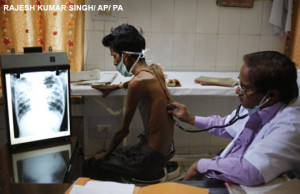 TB. An ancient enemy getting stronger
TB. An ancient enemy getting stronger
• BMJ is supporting the World Health Organization’s End TB strategy by highlighting World TB Day today and offering free access to TB papers and resources.
In an editorial for The BMJ, Zarir F Udwadia et al write that TB is India’s silent epidemic and a death sentence for poor people. In separate personal view pieces, Yogesh Jain et al suggest India should screen all tuberculosis patients for drug resistant disease at diagnosis, and Mike Frick et al urge we end the use of stigmatizing language—disease of poverty, treatment defaulter, TB suspect, non-compliant—in tuberculosis research and practice.
In her latest blog, Grania Brigden declares it’s time for a jumpstart and insists we start accelerating access to new drug resistant TB drugs. There is more free TB content on our clinical community doc2doc, BMJ Learning, and BMJ’s specialty journal Thorax.
Schoolchildren’s salt intake
 • Feng J He et al evaluated whether School-EduSalt, an education programme targeted at schoolchildren, could lower salt intake in children and their families. The study covered 279 children (mean age of 10.1) and 553 adult family members (mean age 43.8) in northern China over the course of one school term.
• Feng J He et al evaluated whether School-EduSalt, an education programme targeted at schoolchildren, could lower salt intake in children and their families. The study covered 279 children (mean age of 10.1) and 553 adult family members (mean age 43.8) in northern China over the course of one school term.
Children in the intervention group delivered salt reduction messages they had learnt at school to their families. The authors found a reduction in salt intake—measured by 24 hour urinary sodium excretion—in the intervention group, and concluded that such an education programme is a novel, feasible, and effective approach to lowering salt intake in families with schoolchildren.
Cardiac screening for low risk adults
• New guidance from the American College of Physicians suggests that screening asymptomatic low risk adults for coronary heart disease [CHD] is ineffective. David Fleming, the college’s president, categorises it as “low value care” which doesn’t improve outcomes.
Reporting from Seattle for The BMJ, Michael McCarthy explains that the guidance—which is based on a systematic review, recommendations of the US Preventive Services Task Force, and American College of Cardiology guidelines—defines asymptomatic low risk patients as those determined to have a 10 year risk of CHD events of less than 10%, estimated from Framingham and other risk score calculators.
Sabreena Malik is clinical community editor, BMJ. Follow Sabreena @sabreenamalik_1